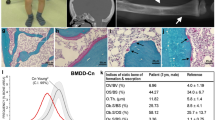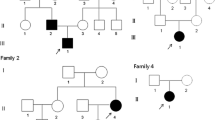Abstract
Osteopetrosis is a disease characterised by a generalized skeletal sclerosis resulting from a reduced osteoclast-mediated bone resorption. Several spontaneous mutations lead to osteopetrotic phenotypes in animals. Moutier et al. (1974) discovered the osteopetrosis (op) rat as a spontaneous, lethal, autosomal recessive mutant. op rats have large nonfunctioning osteoclasts and severe osteopetrosis. Dobbins et al. (2002) localized the disease-causing gene to a 1.5-cM genetic interval on rat chromosome 10, which we confirm in the present report. We also refined the genomic localization of the disease gene and provide statistical evidence for a disease-causing gene in a small region of rat chromosome 10. Three strong functional candidate genes are within the delineated region. Clcn7 was previously shown to underlie different forms of osteopetrosis, in both human and mice. ATP6v0c encodes a subunit of the vacuolar H(+)-ATPase or proton pump. Mutations in TCIRG1, another subunit of the proton pump, are known to cause a severe form of osteopetrosis. Given the critical role of proton pumping in bone resorption, the Slc9a3r2 gene, a sodium/hydrogen exchanger, was also considered as a candidate for the op mutation. RT-PCR showed that all 3 genes are expressed in osteoclasts, but sequencing found no mutations either in the coding regions or in intron splice junctions. Our ongoing mutation analysis of other genes in the candidate region will lead to the discovery of a novel osteopetrosis gene and further insights into osteoclast functioning.




Similar content being viewed by others
References
de Vernejoul MC (2008) Sclerosing bone disorders. Best Pract Res Clin Rheumatol 22:71–83
Kornak U, Kasper D, Bosl MR, Kaiser E, Schweizer M, Schulz A, Friedrich W, Delling G, Jentsch TJ (2001) Loss of the ClC-7 chloride channel leads to osteopetrosis in mice and man. Cell 104:205–215
Sly WS, Hewett-Emmett D, Whyte MP, Yu YS, Tashian RE (1983) Carbonic anhydrase II deficiency identified as the primary defect in the autosomal recessive syndrome of osteopetrosis with renal tubular acidosis and cerebral calcification. Proc Natl Acad Sci USA 80:2752–2756
Chalhoub N, Benachenhou N, Rajapurohitam V, Pata M, Ferron M, Frattini A, Villa A, Vacher J (2003) Grey-lethal mutation induces severe malignant autosomal recessive osteopetrosis in mouse and human. Nat Med 9:399–406
Kornak U, Schulz A, Friedrich W, Uhlhaas S, Kremens B, Voit T, Hasan C, Bode U, Jentsch TJ, Kubisch C (2000) Mutations in the a3 subunit of the vacuolar H(+)-ATPase cause infantile malignant osteopetrosis. Hum Mol Genet 9:2059–2063
Frattini A, Orchard PJ, Sobacchi C, Giliani S, Abinun M, Mattsson JP, Keeling DJ, Andersson AK, Wallbrandt P, Zecca L, Notarangelo LD, Vezzoni P, Villa A (2000) Defects in TCIRG1 subunit of the vacuolar proton pump are responsible for a subset of human autosomal recessive osteopetrosis. Nat Genet 25:343–346
Van Wesenbeeck L, Odgren PR, Coxon FP, Frattini A, Moens P, Perdu B, Mackay CA, Van Hul E, Timmermans JP, Vanhoenacker F, Jacobs R, Peruzzi B, Teti A, Helfrich MH, Rogers MJ, Villa A, Van Hul W (2007) Involvement of PLEKHM1 in osteoclastic vesicular transport and osteopetrosis in incisors absent rats and humans. J Clin Invest 117:919–930
Sobacchi C, Frattini A, Guerrini MM, Abinun M, Pangrazio A, Susani L, Bredius R, Mancini G, Cant A, Bishop N, Grabowski P, Del Fattore A, Messina C, Errigo G, Coxon FP, Scott DI, Teti A, Rogers MJ, Vezzoni P, Villa A, Helfrich MH (2007) Osteoclast-poor human osteopetrosis due to mutations in the gene encoding RANKL. Nat Genet 39:960–962
Guerrini MM, Sobacchi C, Cassani B, Abinun M, Kilic SS, Pangrazio A, Moratto D, Mazzolari E, Clayton-Smith J, Orchard P, Coxon FP, Helfrich MH, Crockett JC, Mellis D, Vellodi A, Tezcan I, Notarangelo LD, Rogers MJ, Vezzoni P, Villa A, Frattini A (2008) Human osteoclast-poor osteopetrosis with hypogammaglobulinemia due to TNFRSF11A (RANK) mutations. Am J Hum Genet 83:64–76
Driessen GJ, Gerritsen EJ, Fischer A, Fasth A, Hop WC, Veys P, Porta F, Cant A, Steward CG, Vossen JM, Uckan D, Friedrich W (2003) Long-term outcome of haematopoietic stem cell transplantation in autosomal recessive osteopetrosis: an EBMT report. Bone Marrow Transplant 32:657–663
Cotton WR, Gaines JF (1974) Unerupted dentition secondary to congenital osteopetrosis in the Osborne-Mendel rat. Proc Soc Exp Biol Med 146:554–561
Van Wesenbeeck L, Odgren PR, MacKay CA, D’Angelo M, Safadi FF, Popoff SN, Van Hul W, Marks SC Jr (2002) The osteopetrotic mutation toothless (tl) is a loss-of-function frameshift mutation in the rat Csf1 gene: evidence of a crucial role for CSF-1 in osteoclastogenesis and endochondral ossification. Proc Natl Acad Sci USA 99:14303–14308
Dobbins DE, Sood R, Hashiramoto A, Hansen CT, Wilder RL, Remmers EF (2002) Mutation of macrophage colony stimulating factor (Csf1) causes osteopetrosis in the tl rat. Biochem Biophys Res Commun 294:1114–1120
Marks SC Jr (1973) Pathogenesis of osteopetrosis in the ia rat: reduced bone resorption due to reduced osteoclast function. Am J Anat 138:165–189
Moutier R, Ostrowski K, Lamendin H (1989) Microphthalmia: a new recessive mutation in the Norway rat. J Hered 80:76–78
Weilbaecher KN, Hershey CL, Takemoto CM, Horstmann MA, Hemesath TJ, Tashjian AH, Fisher DE (1998) Age-resolving osteopetrosis: a rat model implicating microphthalmia and the related transcription factor TFE3. J Exp Med 187:775–785
Moutier R, Toyama K, Charrier MF (1974) Genetic study of osteopetrosis in the Norway rat. J Hered 65:373–375
Marks SC Jr, Popoff SN (1989) Osteoclast biology in the osteopetrotic (op) rat. Am J Anat 186:325–334
Milhaud G, Labat ML, Graf B, Juster M, Balmain N, Moutier R, Toyama K (1975) Kinetic, radiographic, and histologic demonstration of the curing of congenital osteopetrosis in rats. CR Acad Sci Hebd Seances Acad Sci D 280:2485–2488
Nisbet NW, Waldron SF, Marshall MJ (1983) Failure of thymic grafts to stimulate resorption of bone in the Fatty/Orl-op rat. Calcif Tissue Int 35:122–125
Remmers EF, Du Y, Ding YP, Kotake S, Ge L, Zha H, Goldmuntz EA, Hansen C, Wilder RL (1996) Localization of the gene responsible for the op (osteopetrotic) defect in rats on chromosome 10. J Bone Miner Res 11:1856–1861
Dobbins DE, Joe B, Hashiramoto A, Salstrom JL, Dracheva S, Ge L, Wilder RL, Remmers EF (2002) Localization of the mutation responsible for osteopetrosis in the op rat to a 1.5-cM genetic interval on rat chromosome 10: identification of positional candidate genes by radiation hybrid mapping. J Bone Miner Res 17:1761–1767
Yoshida H, Hayashi S, Kunisada T, Ogawa M, Nishikawa S, Okamura H, Sudo T, Shultz LD (1990) The murine mutation osteopetrosis is in the coding region of the macrophage colony stimulating factor gene. Nature 345:442–444
Pangrazio A, Poliani PL, Megarbane A, Lefranc G, Lanino E, Di Rocco M, Rucci F, Lucchini F, Ravanini M, Facchetti F, Abinun M, Vezzoni P, Villa A, Frattini A (2006) Mutations in OSTM1 (grey lethal) define a particularly severe form of autosomal recessive osteopetrosis with neural involvement. J Bone Miner Res 21:1098–1105
Ramirez A, Faupel J, Goebel I, Stiller A, Beyer S, Stockle C, Hasan C, Bode U, Kornak U, Kubisch C (2004) Identification of a novel mutation in the coding region of the grey-lethal gene OSTM1 in human malignant infantile osteopetrosis. Hum Mutat 23:471–476
Del Fattore A, Peruzzi B, Rucci N, Recchia I, Cappariello A, Longo M, Fortunati D, Ballanti P, Iacobini M, Luciani M, Devito R, Pinto R, Caniglia M, Lanino E, Messina C, Cesaro S, Letizia C, Bianchini G, Fryssira H, Grabowski P, Shaw N, Bishop N, Hughes D, Kapur R, Datta H, Taranta A, Fornari R, Migliaccio S, Teti A (2005) Clinical, genetic and cellular analysis of forty-nine osteopetrotic patients: implications for diagnosis and treatment. J Med Genet (online). Available at: http://jmg.bmj.com/cgi/content/abstract/jmg.2005.036673v1
Seifert MF, Marks SC Jr (1985) Morphological evidence of reduced bone resorption in the osteosclerotic (oc) mouse. Am J Anat 172:141–153
Li YP, Chen W, Liang Y, Li E, Stashenko P (1999) Atp6i-deficient mice exhibit severe osteopetrosis due to loss of osteoclast-mediated extracellular acidification. Nat Genet 23:447–451
Acknowledgments
This work was supported by Grant DE07444 to P.R.O. B.P. holds a Ph.D. studentship from the European Calcified Tissue Society. This work was supported by F.W.O. Vlaanderen Grant G.0117.06 and by a grant from the Special Research Fund (B.O.F.) of the University of Antwerp, both to W.V.H.
Author information
Authors and Affiliations
Corresponding author
Rights and permissions
About this article
Cite this article
Perdu, B., Odgren, P.R., Van Wesenbeeck, L. et al. Refined Genomic Localization of the Genetic Lesion in the Osteopetrosis (op) Rat and Exclusion of Three Positional and Functional Candidate Genes, Clcn7, Atp6v0c, and Slc9a3r2 . Calcif Tissue Int 84, 355–360 (2009). https://doi.org/10.1007/s00223-009-9229-7
Received:
Accepted:
Published:
Issue Date:
DOI: https://doi.org/10.1007/s00223-009-9229-7




